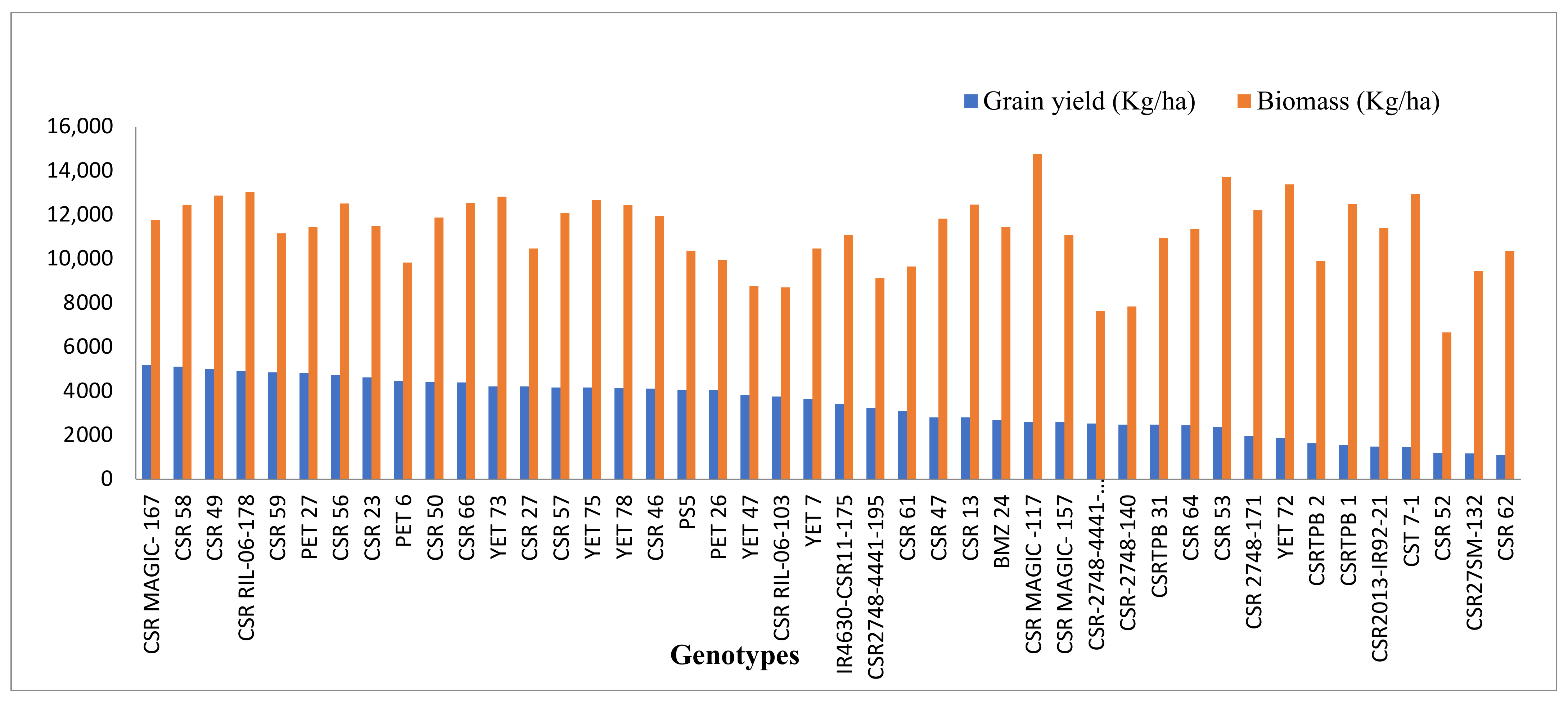Identifying Rice Genotypes Suitable for Aerobic Direct-Seeded Conditions †
Abstract
:1. Introduction
2. Materials and Methods
3. Results and Discussion
4. Conclusions
Author Contributions
Funding
Informed Consent Statement
Acknowledgments
Conflicts of Interest
References
- Wang, W.X.; Jie, D.U.; Zhou, Y.Z.; Zeng, Y.J.; Tan, X.M.; Pan, X.H.; Shi, Q.H.; Wu, Z.M.; Zeng, Y.H. Effects of different mechanical direct seeding methods on grain yield and lodging resistance of early indica rice in South China. J. Integr. Agric. 2021, 20, 1204–1215. [Google Scholar] [CrossRef]
- Chen, S.; Liu, S.; Zheng, X.; Yin, M.; Chu, G.; Xu, C.; Yan, J.; Chen, L.; Wang, D.; Zhang, X. Effect of various crop rotations on rice yield and nitrogen use efficiency in paddy–upland systems in southeastern China. Crop J. 2018, 6, 576–588. [Google Scholar] [CrossRef]
- Li, S.; Jiang, H.; Wang, J.; Wang, Y.; Pan, S.; Tian, H.; Duan, M.; Wang, S.; Tang, X.; Mo, Z. Responses of plant growth, physiological, gas exchange parameters of super and non-super rice to rhizosphere temperature at the tillering stage. Sci. Rep. 2019, 9, 10618. [Google Scholar] [CrossRef] [PubMed]
- Ministry of Agricultural and Farmers Welfare. Pocket Book of Agricultural Statistics 2019; Ministry of Agricultural and Farmers Welfare: New Delhi, India, 2019.
- Bhushan, L.; Ladha, J.K.; Gupta, R.K.; Singh, S.; Tirol-Padre, A.; Saharawat, Y.S.; Gathala, M.; Pathak, H. Saving of water and labor in a rice-wheat system with no-tillage and direct seeding technologies. Agron. J. 2007, 99, 1288–1296. [Google Scholar] [CrossRef]
- Pandey, S.; Velasco, L. Trends in crop establishment methods in Asia and research issues. Rice Is Life Sci. Perspect. 21st Century 2005, 178–181. [Google Scholar]
- Kakraliya, S.K.; Singh, L.; Yadav, A.K.; Jat, H.; Kakraliya, S.; Choudhary, K.; Datta, A. Smart package and practices for direct seeded rice (DSR). Innov. Farming 2016, 1, 49–55. [Google Scholar]
- Quilloy, F.A.; Labaco, B.; Dixit, S.; Casal, C., Jr. Crop Establishment in Direct-Seeded Rice: Traits, Physiology, and Genetics. Rice Improv. 2021, 171–202. [Google Scholar] [CrossRef]
- Bhandaria, S.; Khanala, S.; Dhakalb, S. Adoption of direct seeded rice (dsr) over puddled-transplanted rice (TPR) for resource conservation and increasing wheat yield. Rev. Food Agric. 2020, 1, 44–51. [Google Scholar] [CrossRef]
- Xu, L.; Li, X.; Wang, X.; Xiong, D.; Wang, F. Comparing the grain yields of direct-seeded and transplanted rice: A meta-analysis. Agronomy 2019, 9, 767. [Google Scholar] [CrossRef] [Green Version]
- Liu, H.; Hussain, S.; Zheng, M.; Peng, S.; Huang, J.; Cui, K.; Nie, L. Dry direct-seeded rice as an alternative to transplanted-flooded rice in Central China. Agron. Sustain. Dev. 2015, 35, 285–294. [Google Scholar] [CrossRef] [Green Version]
- Susilawati, H.L.; Setyanto, P.; Kartikawati, R.; Sutriadi, M.T. The opportunity of direct seeding to mitigate greenhouse gas emission from paddy rice field. In IOP Conf. Ser. Earth Environ. Sci. 2019, 393, 12042. [Google Scholar] [CrossRef]
- Rao, A.N.; Johnson, D.E.; Sivaprasad, B.; Ladha, J.K.; Mortimer, A.M. Weed management in direct-seeded rice. Adv. Agron. 2007, 93, 153–255. [Google Scholar] [CrossRef]
- Joshi, E.; Kumar, D.; Lal, B.; Nepalia, V.; Gautam, P.; Vyas, A.K. Management of direct seeded rice for enhanced resource-use efficiency. Plant Knowl. J. 2013, 2, 119–134. [Google Scholar]
- Sandhu, N.; Yadav, S.; Kumar Singh, V.; Kumar, A. Effective Crop Management and Modern Breeding Strategies to Ensure Higher Crop Productivity under Direct Seeded Rice Cultivation System: A Review. Agronomy 2021, 11, 1264. [Google Scholar] [CrossRef]
- Khokhar, J.S.; Sarial, A.K. Evaluation of Indian Rice Varieties under Direct Seeded and Transplanted Rice Production Systems for Grain Yield and Quality Traits. Int. J. Pure Appl. Biosci. 2018, 6, 1107–1115. [Google Scholar] [CrossRef]
- Yaqoob, M.; Anjum, R.; Hussain, M.; Shah, M.J. Genetic diversity analysis and character association in some Chinese hybrid rice under dry conditions. Pak. J. Agric. Res. 2012, 25, 249–256. [Google Scholar]
- Eradasappa, E.; Nadarajan, N.; Ganapathy, K.N.; Shanthala, J.; Satish, R.G. Correlation and path analysis for yield and its attributing traits in rice (Oryza sativa L.). Crop Res. Hisar. 2007, 34, 156. [Google Scholar]

| Source | DF | Yield | Biomass | Height | Tillers | Panicle Length |
|---|---|---|---|---|---|---|
| Genotype | 43 | 8,124,772.54 ** | 14,051,913.10 ** | 670.98 ** | 9.06 ** | 29.85 ** |
| Year | 1 | 141,567.34 | 55,559,133.40 ** | 491.90 ** | 131.10 ** | 7.51 * |
| Genotype: Year | 43 | 951,238.66 * | 6,190,075.88 ** | 64.02 ** | 7.30 ** | 4.21 ** |
| Pooled Error | 132 | 597,957.95 | 2,153,000.63 | 18.29 | 3.87 | 1.45 |
Publisher’s Note: MDPI stays neutral with regard to jurisdictional claims in published maps and institutional affiliations. |
© 2022 by the authors. Licensee MDPI, Basel, Switzerland. This article is an open access article distributed under the terms and conditions of the Creative Commons Attribution (CC BY) license (https://creativecommons.org/licenses/by/4.0/).
Share and Cite
Goyal, A.; Sharma, P.C.; Munjal, R.; Krishnamurthy, S.L.; Jat, H.S.; Lokeshkumar, B.M.; Kumar, V. Identifying Rice Genotypes Suitable for Aerobic Direct-Seeded Conditions. Environ. Sci. Proc. 2022, 16, 68. https://doi.org/10.3390/environsciproc2022016068
Goyal A, Sharma PC, Munjal R, Krishnamurthy SL, Jat HS, Lokeshkumar BM, Kumar V. Identifying Rice Genotypes Suitable for Aerobic Direct-Seeded Conditions. Environmental Sciences Proceedings. 2022; 16(1):68. https://doi.org/10.3390/environsciproc2022016068
Chicago/Turabian StyleGoyal, Alisha, Parbodh C. Sharma, Renu Munjal, Saraswathipura L. Krishnamurthy, Hanuman S. Jat, Bayragondlu M. Lokeshkumar, and Virender Kumar. 2022. "Identifying Rice Genotypes Suitable for Aerobic Direct-Seeded Conditions" Environmental Sciences Proceedings 16, no. 1: 68. https://doi.org/10.3390/environsciproc2022016068
APA StyleGoyal, A., Sharma, P. C., Munjal, R., Krishnamurthy, S. L., Jat, H. S., Lokeshkumar, B. M., & Kumar, V. (2022). Identifying Rice Genotypes Suitable for Aerobic Direct-Seeded Conditions. Environmental Sciences Proceedings, 16(1), 68. https://doi.org/10.3390/environsciproc2022016068






